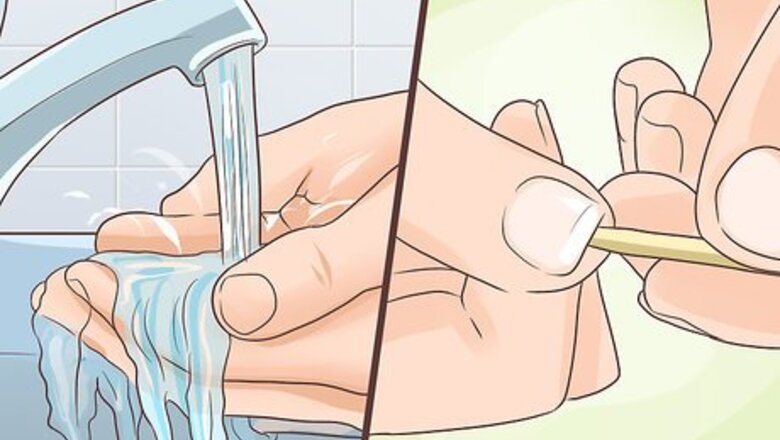
views
X
Trustworthy Source
American Academy of Opthamologists
Professional medical organization focused on advocating for public health and supporting sight-related research
Go to source
While you might feel frustrated, take a few deep breaths so that your hands are steady enough to remove it. You can often pinch out the pieces like you would an intact lens, but it may be difficult to do this if the ripped piece is small. Research suggests that rinsing your eye with saline solution may help dislodge a stuck piece, but visit your eye doctor if you're having trouble removing the broken contact.[2]
X
Research source
Removing a Broken Contact Lens
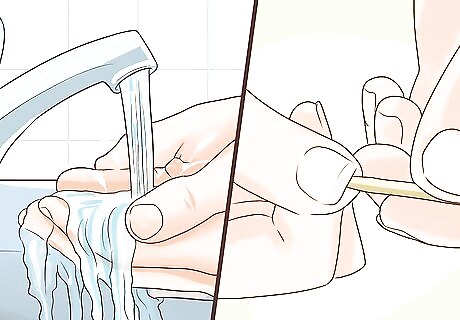
Wash your hands. Before attempting to remove a broken lens, make sure to wash your hands well. Wash them for 30 seconds, and make sure to remove any dirt or oils under your fingernails. Dry them with a lint-free towel. Use a soap that is free from perfumes to reduce the risk of irritation.

Find a mirror and hold your eyelid open. Get close to a mirror and use your thumb to hold your lower eyelid open and your index finger to hold your upper eyelid open. Try to locate the bits of contact lens in your eye with your other seeing eye. You might need a helper to direct you, especially if your eyesight prevents you from clearly seeing the lens fragments. Your helper should stick to giving direction and should not put their fingers in your eye or attempt to remove it themselves.
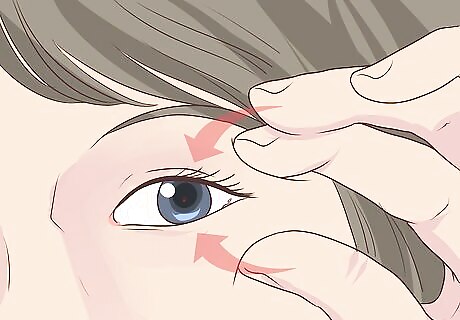
Remove larger pieces. Remove any large or easy to find pieces first as you would an intact lens. Move these pieces to the white of your eye. Carefully pinch them with the tips of your thumb and index finger (don't use your nails). Don’t throw any pieces away. Keep them in your contact lens case so they can help you determine if you’ve located and removed all fragments from your eye.
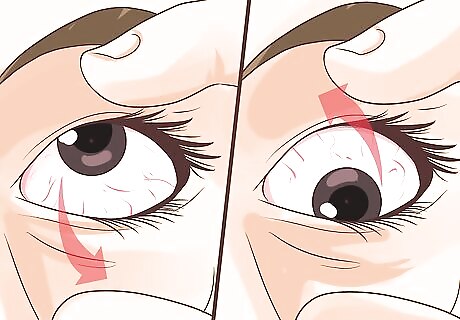
Move your eye around to locate smaller pieces. Carefully move your eye up and down and side to side in order to locate smaller pieces. Try to hold your eyelids open as widely as possible in order to avoid scratching the surface of your eye. Small, jagged fragments might cause damage if they rub in between your eyelid or fingers and eye surface, so be very gentle in removing them.
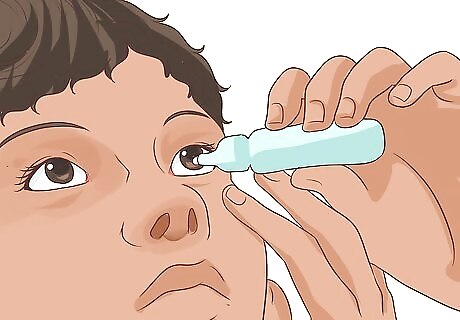
Flush your eye to get rid of any remaining pieces. Check the label of your contact lens disinfectant to ensure that it’s safe to use for flushing your eye, or saline eye drops if you have them handy. Flush your eye with the solution, and try to let the liquid guide any remaining tiny pieces out of your eye. Continue to hold your eyelids wide open to let the solution and any leftover fragments drip out from your eye and socket. You may still feel like you have pieces stuck in your eye, since the fragments could have caused irritation. Use the pieces that you recovered and stored in your lens case to try to judge whether or not any pieces actually remain.

Visit your eye doctor if you have difficulty. If you’re unable to remove lens fragments using pinching or flushing techniques, you might have to visit your eye doctor. Making a quick visit to the doctor might seem like a hassle, but it’s certainly preferable to doing yourself harm by trying to get the broken lens out yourself. Your doctor will have more sensitive tools than you have at your disposal, and will more than likely be able to quickly and easily remove the pieces for you. See your doctor right away if your lens has scratched your eye.
Avoiding Eye Damage
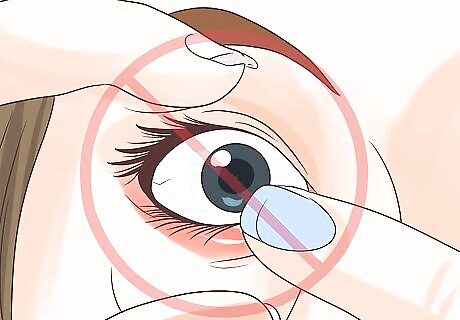
Don’t use your fingernails. You might be tempted to use your fingernails to pluck the lens fragments from your eye; however, it’s important to pinch the lens pieces with your fingertips only rather than your nails. Otherwise, you risk doing damage to the surface of your eye. Further, it’s ideal to attempt removing a broken contact with fingers that have trimmed nails to avoid scratching your eye.
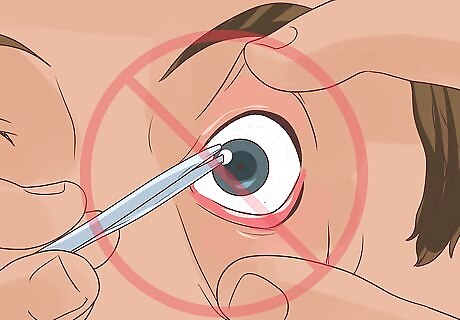
Steer clear of tweezers. If you’re unable to remove lens fragments with your fingertips, do not attempt to use any tools. Tweezers and similar objects can severely damage the surface of your eye or cause serious infection. Leave the equipment handling to your doctor. Even soft-tipped contact lens tweezers are generally not recommended, especially for removing lens fragments. The risk of causing an abrasion, or scratching the eye surface, is too great.
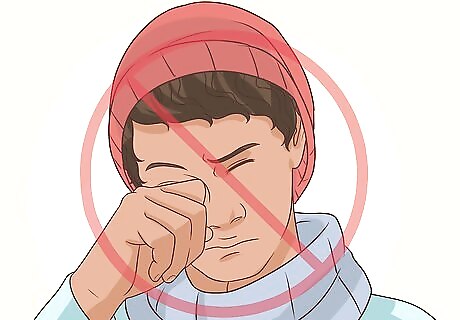
Try not to rub your eyes. Don’t rub your eyes hard if any lens fragments are stuck in your eye. The friction could scratch your cornea, or the eye’s surface. You risk not only doing physical damage, but you open the door to dangerous eye infections. In general, you should avoid rubbing your eyes too much while you’re wearing contact lenses.
Preventing Contacts from Breaking and Getting Stuck
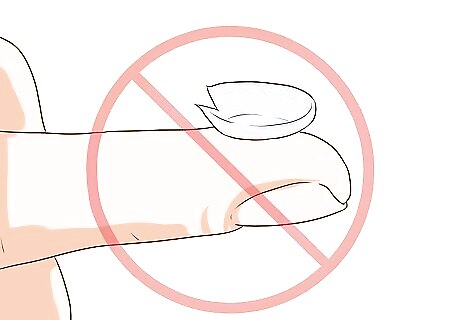
Never use a torn lens. Carefully inspect your contacts before using them. Do not use a lens if you notice any tears or warping, no matter how minute they seem. Even using a warped hard lens can be dangerous, as it might alter the shape of your cornea, or the surface of eye that the lens fits onto. Try to keep spare glasses or extra lenses on you when you’re on the go or out of town. This will reduce the temptation or need to use faulty lenses.

Handle and maintain your lenses as directed. When you remove lenses from your eyes, don’t hold them in between your fingers before placing them in solution. Rather, hold them on a fingertip facing up, so the part that comes in contact with your eye doesn’t touch your finger. This will reduce the risk of weakening the lens or changing its shape, making it less likely to tear or hurt your cornea. Promptly and gently place the lenses in their case after removing them from your eyes. Don’t let lenses dry out, as they won’t completely rehydrate and the risk of tearing will greatly increase. Always take care closing your case, and make sure you don’t pinch the lenses in the lid. Don’t put your lenses in your mouth or tongue to lubricate them. Replace your lenses according to their manufacturer guidelines and replace your case every three months.

Don’t sleep with your lenses on. Your eyes and lenses are prone to drying out while you sleep, and you’re not awake to properly maintain or lubricate them. Rapid eye movement during sleep can also displace lenses or damage the eye surface. This can also increase the risk of serious eye infections. Extended wear contacts should be a conversation between you and your doctor. The FDA has approved overnight wear for some extended wear lenses, but some experts still believe extended wear lenses should not be worn overnight.



















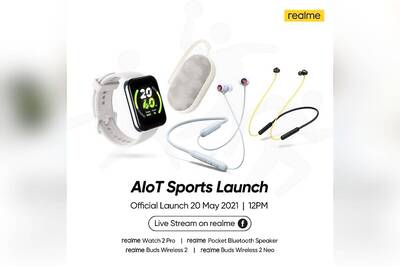
Comments
0 comment